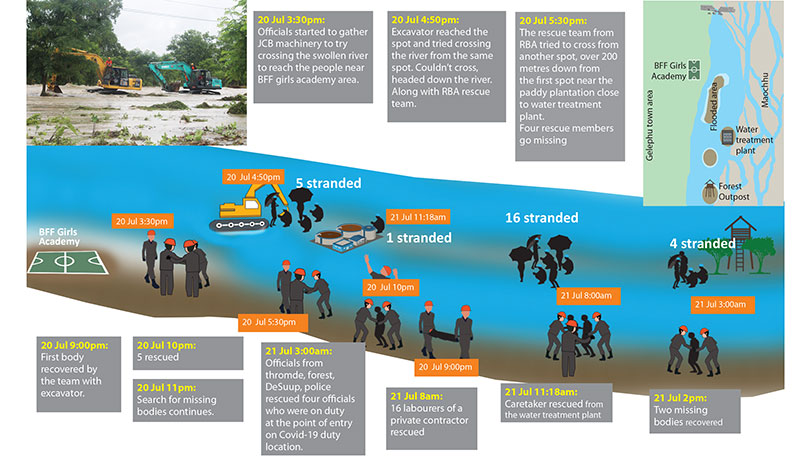Missing bodies recovered
Nima | Gelephu
Migma Norbu Sherpa along with his staff of a private crushing unit climbed on a mound of sand and boulders when the Maochhu level started to increase.
Migma Norbu Sherpa and 15 other people were stranded at the crushing unit located over 100 metres down the water treatment plant when the river level started to increase at around 12:30am on Monday. They didn’t dare to escape by crossing the river. It was too late.
On the other side of the swollen river was a lone man, who was stranded overnight at the Thromde water treatment plant. Dendup Gyeltshen climbed on one of the water tanks as the water level kept rising.

“We tried to bring the caretaker with us towards midnight but to no avail. He was alone,” said Migma Norbu Sherpa.
As the water level started to fall the next morning, Migma Norbu Sherpa and his group of 16 people, all stranded near the water treatment plant overnight were helped by the rescue team comprising of Royal Bhutan Army soldiers, police, DeSuups, forest and thromde officials among others at 8am yesterday. The staff of the crushing unit was working at the site for the past two years with family and children.
On the same night, four forest officials who were on Covid-19 duty at an observation point near the border area were also stranded towards the end of Maochhu where two observation points were built close to the border until 3am. Their colleagues along with the rescue team helped them to safety.

The works to reach the stranded people resumed by 4am yesterday after heavy rainfall increased water level and stopped the team from trying further on Monday night.
“I had my diner around 3:30am. I don’t know what I ate,” said one of the rescue officials. The rescue team also found the two missing bodies of the soldiers yesterday.
Meanwhile, the diversion wall that diverted water to the Thromde treatment plant and the fishery unit had collapsed, leading to the change in the course of Maochhu on July 20, according to officials.
Gelephu gup, Ugyen Wangchuk who is also a DeSuup said there is a need to do proper dredging and river protection walls to reduce the risk of flooding in the area.
“Now the dredging works are completed and the debris started to fill daily. This led to change in the course of the river,” he said. “Without proper dredging and protection walls, the situation would remain the same.
Several tributaries from nearby hills end into Maochhu increasing the water volume during monsoon.
About seven streams and rainwater from Aieslip, Balaykhocha, and Passang chhu, Jogikhola, Dawlakhola, and Shetikhari, among others, flow into the Maochhu.
The diversion wall for the water treatment plant and the fishery was constructed in 2000, according to sources.
The water level at Maochhu during the flood increased to over 11.1 metres because of heavy rainfall. The highest rise in water level was reported at noon on Monday.
Officials from National Center for Hydrology and Meteorology (NCHM) said plans to install early warning systems at the critical flood areas are being explored. “The advisory warning of flood and heavy rainfall in the southern region on July 18, 19 and 20 were announced,” he said.
The flooding has also caused minor damages to the paddy plantation located near the riverbank. However, the damages to the water treatment plant could not be assessed yet.
Kuensel could not contact the five contractors who were rescued from near the water treatment plant when the flood occurred.


